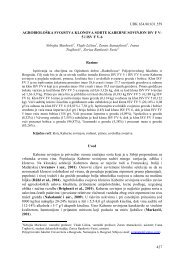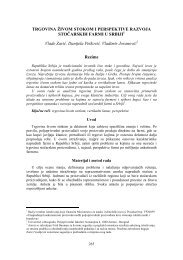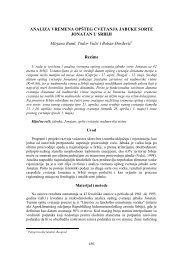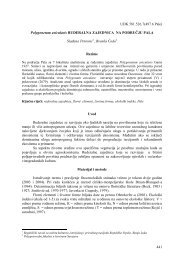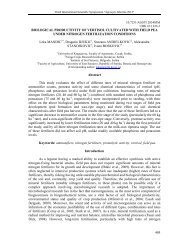178 POMOLOGICAL CHARACTERISTICS OF SOME RASPBERRY ...
178 POMOLOGICAL CHARACTERISTICS OF SOME RASPBERRY ...
178 POMOLOGICAL CHARACTERISTICS OF SOME RASPBERRY ...
You also want an ePaper? Increase the reach of your titles
YUMPU automatically turns print PDFs into web optimized ePapers that Google loves.
Third International Scientific Symposium "Agrosym Jahorina 2012"<br />
10.7251/AGSY1203<strong>178</strong>K<br />
UDK 634.1/.7 (497.15 Bratunac)<br />
<strong>POMOLOGICAL</strong> <strong>CHARACTERISTICS</strong> <strong>OF</strong> <strong>SOME</strong> <strong>RASPBERRY</strong> VARIETIES<br />
GROWN IN THE CONDITIONS <strong>OF</strong> BRATUNAC REGION<br />
Mirko KULINA 1 , Ranko POPOVIC 2 , Mirjana STOJANOVIC 1 , Goran POPOVIC 2 , Radisav<br />
KOJOVIC 3<br />
1 Facultu of Agriculture, University of East Sarajevo, Republic of Srpska, Bosnia & Herzegovina<br />
2 Biotechnical faculty, University of Podgorica, Montenegro.<br />
3 Agricultural faculty University of Kragujevac, Cacak, Serbia<br />
(Corresponding author: kulinamirko@yahoo.com)<br />
Abstract<br />
The aim of this research was to study physical and chemical fruit characteristics of<br />
some raspberry types in row planting system in agro-ecological conditions of Bratunac and to<br />
determine validity of existing planting and introduction of raspberry types. Among the studied<br />
types Meeker expressed better physical and chemical fruit characteristics than other two<br />
examined types Willamette and Heritage.<br />
Keywords: raspberry, cultivar, fruit quality<br />
Introduction<br />
Raspberry (Rubus sp.) is, after strawberry, the most important berry fruit type.<br />
According to the data of International Organization for Agriculture and Food (FAO), for<br />
2009, raspberry world production was organised on 91 257 ha with total production of 486<br />
889 tons of this fruit, and average yield of 5.3 t/ha. The biggest producers of raspberry in the<br />
world are Russia (120 000 t), Serbia (86 961 t), Poland (81 778 t) and USA (60 056 t). The<br />
biggest exporter of raspberry is Serbia with 63 000 tons exported with achieved income of 200<br />
million dollars. In accordance to the data of the Bureau of Statistics of the Republic of Srpska<br />
for 2009/2010, raspberry production in Bosnia and Herzegovina was organized on 1 031 ha<br />
with the total production of 8 487 tons and average yield of 8.2 t/ha. There are 754 ha under<br />
raspberries in the Republic of Srpska with the total production of 5 129 tons and average yield<br />
of 6.8 t/ha.<br />
There are more than 1 200 types of red, black and purple raspberries in the world, but<br />
the number of economically important ones is small (Mišić and Nikolić, 2003). Also, it has<br />
been intensively worked on plant production and creating new types of raspberry in the world,<br />
which, in its genetically base, will consolidate basic requests of producers, processors and<br />
consumers. One of the aims of plant production is also extension of the season of fresh<br />
raspberry fruit consumption.<br />
Materials and methods<br />
Research was done in plantation of raspberry types Willamette, Meeker and Heritage,<br />
located in village Bjelovac, near Bratunac. The plantation was established in the form of<br />
vertical system for Willamette and Heritage types, and T-row for type Meeker. The distance<br />
between rows for all three plots was 2.3 m and in one running meter of row 6 raspberry plants<br />
were planted. Planting was done with certified nursery plants in spring 2007.<br />
During the research, all pomo-technical measures within winter and green pruning<br />
were done, respecting the principles of type specificity. It should be mentioned that the system<br />
<strong>178</strong>
Third International Scientific Symposium "Agrosym Jahorina 2012"<br />
of winter pruning was done with the type Heritage, where the complete upper part of plant is<br />
removed, with goal to obtain fruits only on primocanes of fruits. In that way significantly<br />
longer period of ripening (60 – 80 days) can be provided, what would later reflect on<br />
specificity of this system on methods applied during the research.<br />
As a material in this work we used raspberry types Willamette, Meeker and Heritage.<br />
Willamette is the most present in raspberry production in Bosnia and Herzegovina. Type<br />
Meeker is marked as perspective and highly productive one, with a trend of increasing<br />
surfaces, and the type Heritage is newly introduced primocane fruiting type which<br />
development and expansion are still negligible. Researches were done in 2011, and sampling<br />
of fruit was done in accordance to the principle of “random selection“ in a production nursery.<br />
From pomological characteristics of examined types, the following ones were analysed: fruit<br />
weight (g); fruit length (mm); fruit width (mm); thickness of fruit (mm), number and mass of<br />
seeds; chemical fruit composition: total content of soluble solids (%); total sugar content (%);<br />
sucrose content (%); total acid content (%); pH value. Among biological features, fruitiness<br />
and dynamics of type ripening were also analysed.<br />
Fruit weight was determined on the sample of 30 fruits of each above mentioned types,<br />
by measuring on analytical scales brand Chyo type „Petit balance“, with the exactness of<br />
1/100 g. Fruit length, width and thickness were measured by movable measure, brand „GOST<br />
166-80“ with the exactness of 0.1 mm and measurable extent 0-125 mm. Number and mass of<br />
seeds were determined on the sample of 10 fruits of each type, by measuring on analytic scale,<br />
brand Chyo type „Petit balance“, with the exactness of 1/100 g.<br />
Chemical fruit composition: Content of soluble solids was determined refractmetrically.<br />
Content of total acid was measured by titration with 0.1 N NaOH solution, sugar<br />
content (total and inverted) was done volumetrically according to Luff-Schoorl method, and<br />
sucrose content by calculating. The pH value was determined by pH-meter.<br />
Yield potential of examined types was registered by determination of kg/ha and<br />
kg/shoot for each type.<br />
The results for fruit weight are processed by the statistical method of the analyses of<br />
variance for monofactorial experiment. The significance of differences between mean values<br />
is determined by Duncan’s multiple range test at P=0,05.<br />
Variety<br />
Results and discussion<br />
Table 1. Physical fruit characteristics of examined raspberry varieties<br />
Fruit Fruit length Fruit width Fruit thickness Number<br />
weight (g) (mm) (mm) (mm) of seeds<br />
Mass of<br />
seeds/<br />
Willamette 3.51 b 21.33±0.29 20.85±0.33 6.88±0.14 78.6 0.21<br />
Meeker 4.00 a 22.38±0.26 21.29±0.17 6.93±0.093 88.8 0.26<br />
Heritage 3.49 b 21.54±0.31 20.88±0.27 6.85±0.093 98.2 0.24<br />
Means followed by the same letter do not differ significantly according to Duncan’s multiple range test<br />
at P=0,05<br />
Good fruit quality is the basic aim in raspberry production. There are different fruit<br />
colours (red, black, purple and yellow) depending on type. The fruit weight also varies<br />
depending on raspberry type as well as environmental conditions. Thus, the weight of wild<br />
raspberry varies from 1.1 – 1.6 g (Petrovic and Milosevic, 2002), while the fruit weight of<br />
cultivated raspberries range from 3 g to 6 g (Misic and Nikolic, 2003). The results of fruit<br />
weight and dimensions are given in table 1. Minor differences can be observed in fruit<br />
179
Third International Scientific Symposium "Agrosym Jahorina 2012"<br />
dimensions among examined types, and compared with previously published data. Larger fruit<br />
dimensions were recorder in this study.<br />
Veličković et al. (2004) state that the fruit weight of raspberry type Willamette is<br />
about 3.3 g, height 20 mm and width 18 mm. Higher values of fruit weight (4.72 g), height<br />
(24.01 mm) and width (21.60 mm) were previously reported by Stanisavljevic et al. (2004).<br />
In our research the highest average fruit weight was found in the type Meeker (4.00<br />
g.), and the lowest one in the type Heritage (3.49 g.). Also, concerning fruit height and width,<br />
and thickness of fruit, we can observe differences among studied types and these values are a<br />
bit higher than those reported by mentioned authors.<br />
The biggest average length and width were found in the type Meeker (22.38 cm and<br />
21.29 cm), and the lowest ones in the type Willamette (21,33 cm and 20,85 cm). Meeker type<br />
also expressed the highest average thickness of fruit (6,93 cm), and the lowest was observed<br />
in the type Heritage (6.85 cm).<br />
A very high average number of seeds was recorded at the type Heritage (98.2), and the<br />
lowest at Willamette. Researches also showed that the biggest total weight of seeds was<br />
recorded at the type Meeker (0.26 g), and the lowest at Willamette (0.21 g).<br />
Table 2. Chemical fruit characteristics<br />
Variety<br />
Soluble solids Total sugars Inverted sugars Sucrose Total acids pH value<br />
content/ (%) (%)<br />
(%) (%) (%) (0-14)<br />
Willamette 10,00 3,42 2,55 0,83 1,35 3,00<br />
Meeker 13,00 6,54 5,28 1,20 1,19 3,27<br />
Heritage 12,00 6,09 5,13 0,91 2,33 2,90<br />
Nutritional value of raspberry fruit is reflected in relation to sugars and acids content,<br />
taste and aroma.<br />
Fresh raspberry fruit consist up to 18% of dry matter, 7% of total sugars and 3% of<br />
organic acids. Content of basic chemical compounds varies depending on raspberry type,<br />
ecological conditions and level of applied practical measures (Milosević, 1997).<br />
Gavrilovic-Damnjanovic et al. (2004) reported higher content of soluble solids and<br />
acids obtained in fruit of Skeena, Meeker, Chilcotin and Willamette types and content of<br />
soluble dry matters and acids, and among them, the best were Skeena, Meeker, Chilcotin and<br />
Willamette as the standard.<br />
Our results on content of soluble solids are in line with the results of mentioned<br />
authors. The highest soluble solids had in Meeker type (13.00 %), and the lowest type in<br />
Willamette (10.00 %). Meeker type had slightly higher content of soluble solids compared<br />
with Willamette and Meeker, what also may be addressed to better adaptation of the type to<br />
agro-ecological conditions of Bratunac.<br />
The results of total sugar content showed that the highest content had type Meeker<br />
(6.09 %), which is significantly higher compared to results reporter by Velickovic et al.<br />
(2004).<br />
In accordance to the mentioned authors, the content of total sugar ranged from 5.4%<br />
(Meeker) to 6.8% (Tulameen), while the content of inverted sugars was from 4.2% (Meeker)<br />
to 5.8% (Willamette). The results obtained in our study indicate that Meeker type was ranked<br />
the highest in terms of inverted sugars content, followed by Heritage type (5.28% and 5.13%,<br />
respectively). The lowest content was observed in Willamette type (2.55%) which is<br />
significantly lower than that obtained by Velickovic et al. (2004)<br />
Total acids content ranged from 1.19% (Meeker) to 2.33% (Heritage). Obtained results<br />
are in accordance with those reported by Gavrilovic–Damnjanovic et al. (2004) The results of<br />
our researches are in accordance with the results mentioned by Gavrilović-Damnjanović and<br />
180
Third International Scientific Symposium "Agrosym Jahorina 2012"<br />
collaborators (2004). Similar trend can be noted for pH values that varied between 2.90<br />
(Heritage) and 3.27 (Meeker).<br />
Table 3. Total yield of examined raspberry<br />
Variety<br />
Total yield<br />
kg/ha<br />
kg/shoot<br />
Willamette 20 100 0.913<br />
Meeker 22 400 1.02<br />
Heritage 19 800 0.90<br />
The results of yield components of examined raspberry types showed that the highest<br />
yield per hectare had type Meeker (22400 kg), and the lowest Heritage (19800 kg), while type<br />
Willamette had an average yield of 20100 kg/ha.<br />
Table 4. Ripening time of examined raspberry varieties<br />
Dynamics of ripening<br />
Variety<br />
(days)<br />
Beginning End Duration<br />
Willamette 17.06.2011. 21.07.2011. 34<br />
Meeker 14.06.1011. 17.07.2011. 33<br />
Heritage 28.07.2011. 30.09.2011. 64<br />
Ripening time depends on genetically hereditary characteristics of type and climate<br />
conditions before and during ripening process. Raspberry fruits cannot significantly continue<br />
ripening after being picked up, and so they should be picked in full maturity or just a bit<br />
before it. The highest quality of raspberry fruit is achieved when the picking performs in<br />
commercial ripeness. Such fruit have the most delicious taste, they are the most aromatic and<br />
with the best organoleptic characteristics.<br />
The results regarding beginning of fruit ripening showed that the earliest one was<br />
Meeker type, whereas the latest was Heritage as primocane fruiting type. Duration of ripening<br />
period was different and depends of the type. Heritage expressed a very long ripening time<br />
(64 days) with regard to the fact that their fruits are produced on several series of primocanes,<br />
and the lowest was expressed by Miker (33 days), while type Willamette had ripening period<br />
of 34 days.<br />
Marinković et al. (2004) reported that blooming and ripening time of Chilcotin,<br />
Nootka, Skeena and Willamette raspberries grown in Čačak start in the middle of May or in<br />
June (Stanisavljević et al., 1988). These phenological phases began 7 – 14 days later for same<br />
types grown in Pancevacki rit.<br />
Conclusion<br />
On the basis of investigations of important pomological properties of raspberry types,<br />
we have made the following conclusions:<br />
• Agro-ecological conditions of Bratunac region are considered as appropriate for<br />
intensive raspberry production. Among the studied types, Meeker expressed better<br />
physical and chemical fruit characteristics than other two examined types (Willamette<br />
and Heritage), while the lowest qualities were expressed by the variety Willamette, but<br />
without exception of specific characteristics for certain type.<br />
• In accordance to the achieved results concerning economic-biological characteristics<br />
of examined raspberry types, it can be concluded that the intensive production of<br />
standard and perspective floricane fruiting raspberries in the region of Bratunac is<br />
justified. Besides that, introduction of primocane fruiting varieties can provide offseason<br />
raspberry production in this region.<br />
181
Third International Scientific Symposium "Agrosym Jahorina 2012"<br />
References<br />
Finn, C., Knight, V. (2002): What's going in the world of Rubus breeding? Acta Horticulturae<br />
585: 31-38.<br />
Gavrilović-Damnjanović,J.,Mitrović.O., Stanisavljević, M. (2004): Pogodnost ploda nekih<br />
sorti maline za zamrzavanje. Jugosl. voćar. Vol. 38. br. 147–148 (2004/3–4), 215–219.<br />
Marinković, D.,Mišić, D. P., Zec, G., Slavica Čolić (2004): Pomološke osobine sorti maline u<br />
Pančevačkom ritu. Jugosl. voćar. Vol. 38. br. 145–146 (2004/1–2), 91–99.<br />
Mišić, P., Nikolić, M. (2003): Jagodaste voćke. Institut za istraživanja u poljoprivredi<br />
„Srbija“, Beograd.<br />
Petrović, S., Milošević, T. (2002): Malina-Tehnologija i organizacija<br />
proizvodnje.Agronomski fakultet, Čačak.<br />
Stanisavljević, M., Milutinović, M., Tešović, Ž. (1988): Uporedna ispitivanja privrednobioloških<br />
osobina novije introdukovanih sorti maline. Jugoslovensko voćarstvo,<br />
22, 86: 357-364.<br />
Stanisavljević, M., Leposavić, A., Milenković,S., Petrović,S. ( 2004). Biological-pomological<br />
properties of newly raspberry cultivars and selections. Journal of Yugoslav Fruit<br />
Growing, Vol. 37, No 143-144: 123-129.<br />
182





